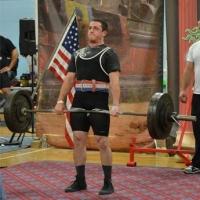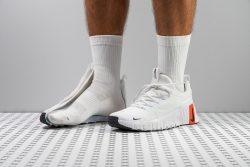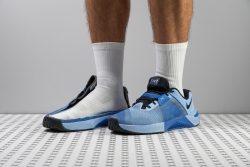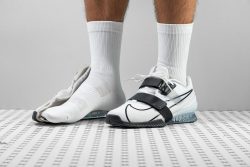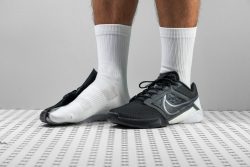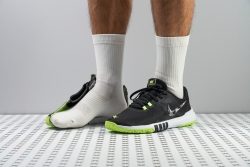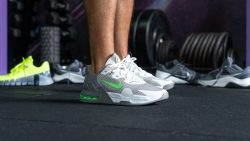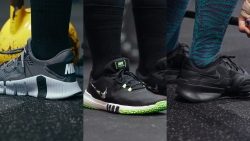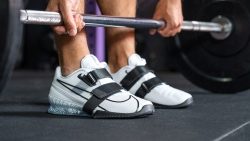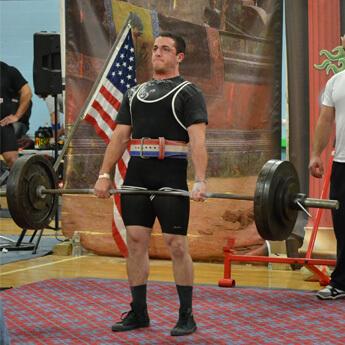7 Best Nike Training Shoes in 2025
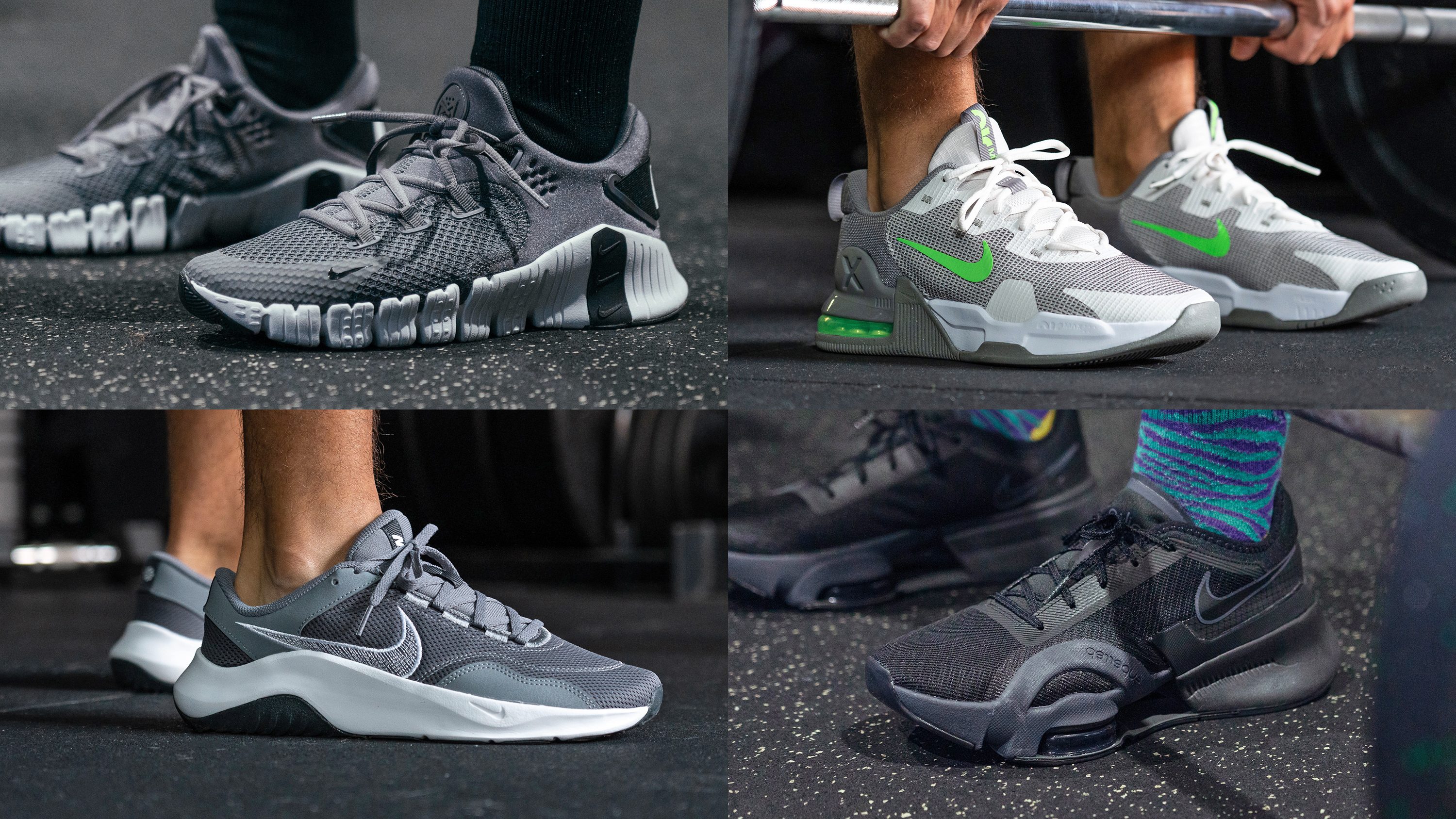
We buy shoes ourselves. We earn commissions when you buy through us, at no extra cost. Why trust us
Nike fans looking for a pair of versatile and dependable training shoes for gym workouts, non-stop jumping, and hardcore weightlifting need not look far. We personally bought and tested Nike training shoes in the gym and in our shoe lab.
Whether you’re a HIIT junkie trying to set a new PB or a beginner weightlifter on the lookout for the most stable kicks to jumpstart your game, we have got you covered.
How we test Nike training shoes
True, Nike training shoes are good-looking and all, but the question is - do they deliver performance-wise? Enter: RunRepeat.
Here at RunRepeat, we are shoe geeks who can tell you which shoes are all hype and which actually work. To achieve this, we do the following:
- Buy shoes using our own money to avoid pressure from brand partnerships.
- Work out and train in the shoes we bought. We head out to our gyms to personally experience what the shoes feature. We check everything - looks, comfort, support, durability.
- Weigh, measure, test, and even stretch and flex every shoe to its limits. We cut the shoes into pieces to have a better view of what we are dealing with inside our lab.
For more information about our testing methodology, check out this link.
Best Nike training shoes overall
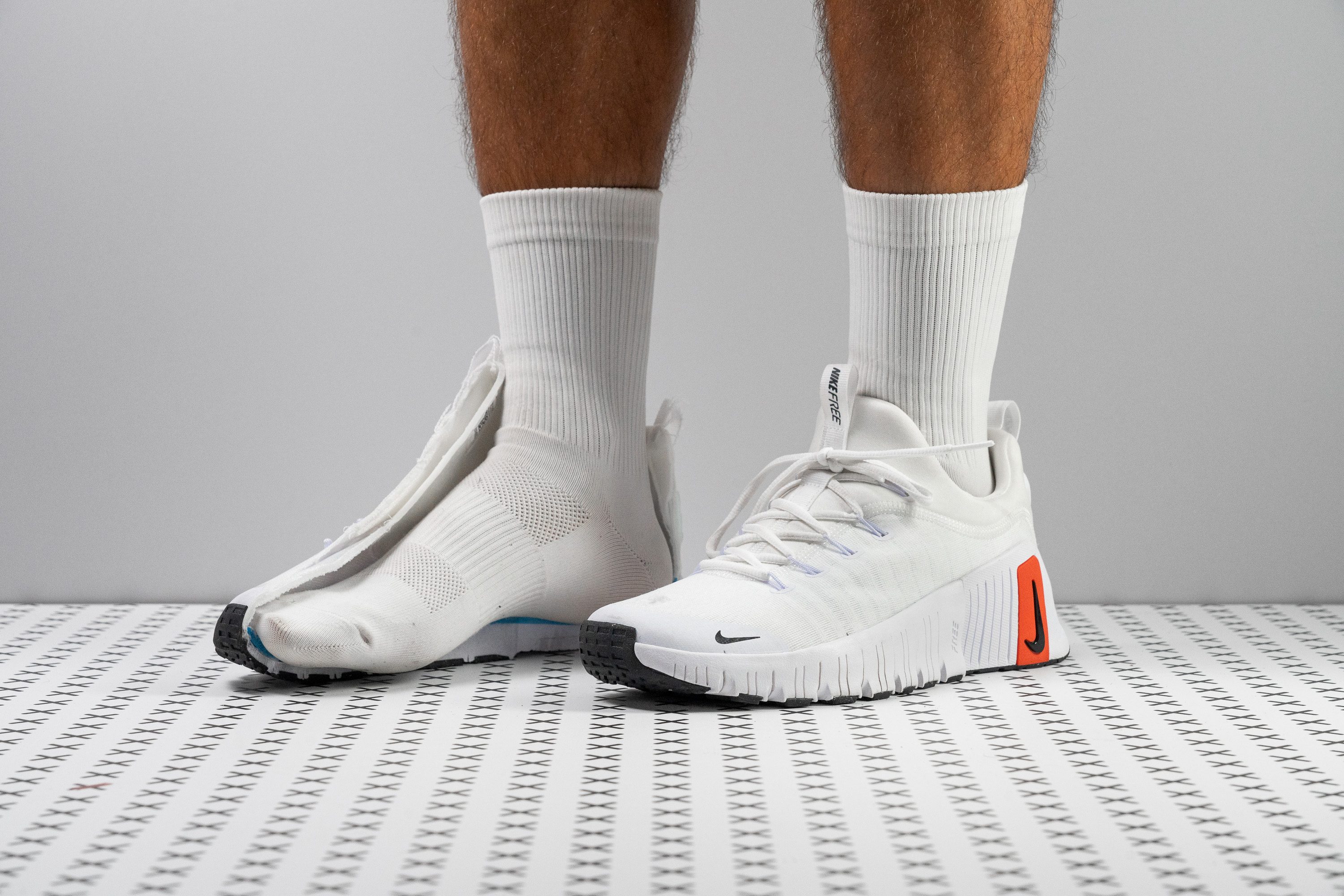





















































What makes it the best?
Combining the Free series’ agility with the Metcon line’s stability, the Free Metcon 6 delivered the best of both worlds in our exercise routines, making it our ultimate Nike training shoe. Our lab validates it's truly a capable all-rounder with its airiness, resilience, and unwavering support.
Its exceptional lightness and flexibility make for a rejuvenating experience, allowing free movement for various workouts—from lunges to planks and burpees. Our feet immediately knew it was airy and our scales validated this with a 9.7 oz (274g) reading vs. the 10.8 oz (306g) average. We manually twisted the shoe and it easily surrendered, receiving a low 2/5 torsional rigidity score. In terms of bend resistance, our jaws dropped when it emerged 76.9% more flexible than average!
Its focus on comfort comes alive as our feet revel in its soft midsole. True enough, our durometer shows it’s 17.9% softer than average. FM6 proves a plush and flexible shoe can be stable by inserting a firmer 27.8 HA foam in the heel and making the base an expansive 113.9/94.4 mm. These resulted in surefooted landings and full confidence as we shifted directions or exercises swiftly.
However, we believe its grounded nature lacks cushioning for repetitive high-impact sessions. Heavy cardio workouts will be more bearable with a thicker stack.
Pros
- Fantastic breathability
- Very light on foot (lighter than average too)
- Abundant cushioning for HIIT
- Most flexible cross-trainer ever
- Excellent stability for moderate weightlifting
- Sock-like fit in a bootie upper
- Accommodating toebox (for medium feet)
- Great grip on gym surfaces
Cons
- NOT for rope climbs (lacks protection)
- Can be hard to put on (narrow opening)
Best Nike training shoes for Crossfit















































What makes it the best?
We tested the limits of Nike trainers in the lab and the gym and found Metcon 10 to be the most suitable for CrossFit. It has a sturdy base and a firm foothold to support our power stance and heavy lifts. It displays flexibility and a reliable grip for agility drills, jumps, and climbs. Metcon 10 handles any WOD we throw at it with ease!
From deadlifts to heavy squats, the wide and sturdy base assists us despite the absence of a raised heel. Our calliper confirms a vast 115.2 mm forefoot and 90.8 mm heel area. With its generous platform, internal midfoot band, and an upper that locks our foot down, we’re able to control our balance. Metcon 10 goes the extra mile by incorporating a non-compressible Hyperlift heel insert for added support when lifting.
Metcon 10 feels versatile for most exercises. In our bend test, it stands 13.2% more malleable than average. It grips well on our wall and rope climbs because of the rubber in the midfoot. In our friction test, it performed strongly with a rating of 0.38, proving its reliable traction.
Given its below-average stack and shock absorption, we learned that Metcon 10 isn’t the most suitable for cardio and rope jumps. It lacks the cushion for repetitive impact. For more cardio-focused sessions, we recommend other trainers.
Pros
- More versatile Metcon overall
- One of the lightest Metcons ever!
- ReactX adds shock absorption and energy return
- Increased forefoot flexibility
- Still amazingly stable for weightlifting
- Fantastic upper durability (even for rope climbs)
- Great grip on gym floors
- Highly secure foot lockdown
- Accommodating fit and toebox
- Handy Lace Tuck
Cons
- Outsole could be more durable
- Upper lacks breathability
Best Nike training shoes for weightlifting
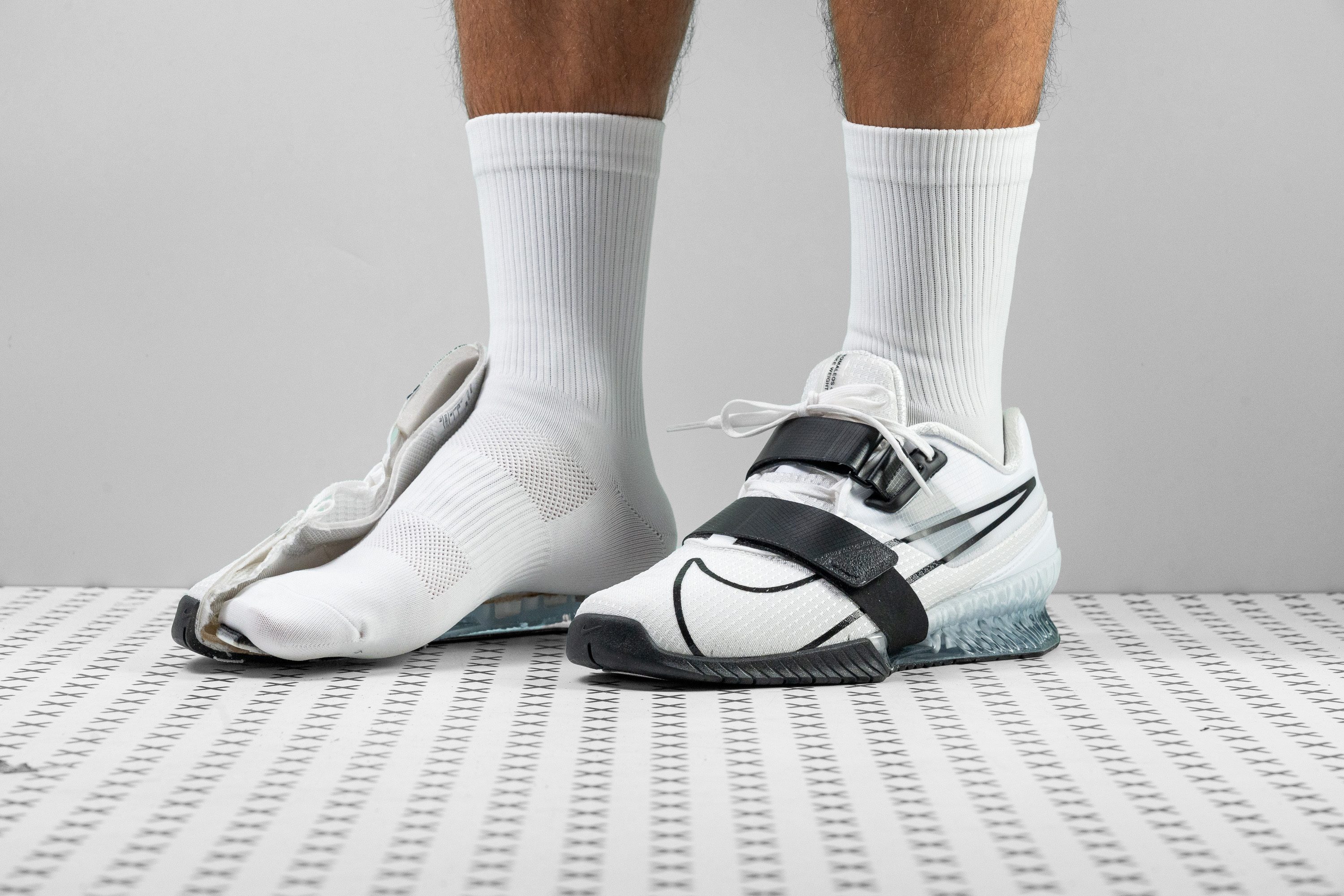






























What makes it the best?
Lifting weights, no matter how heavy, was such a breeze with the Nike Romaleos 4 because of its wide base, very firm heel counter, and effective way of keeping our posture upright. Without a doubt, this shoe is the best for weightlifting among Nike’s trainers.
Just by looking at it, we already saw how wide the midsole platform was. Using a calliper, we ascertained its dimensions. It’s 111.5 mm wide at the forefoot and 91.3 mm wide at the heel. Compared to the averages, these figures are higher by 4.4 mm and 4.2 mm, respectively. Because of the base’s width, we lifted without worries that our feet would slide off the shoe.
The heel counter is also worth a nice mention. It was just so firm that our ankles felt securely locked down. After manually squeezing it in the lab, we gave this part a perfect 5 for stiffness and resistance.
A drop of 20.5 mm didn’t deviate far from the advertised 19.05 mm, and it helped not only in stabilising our feet but also in engaging our calves and straightening out our backs.
The durability of the upper was a source of worry, though. After twelve seconds of Dremel drilling, a see-through hole was already formed.
Pros
- Phenomenal stability
- Sturdy platform and sole
- Better lockdown with two straps
- Comfortable for a lifting shoe
- True to size
- Efficient traction
- Appealing looks
Cons
- Upper lacks durability
- Not for narrow ankles
- Not breathable
Best Nike training shoes for HIIT
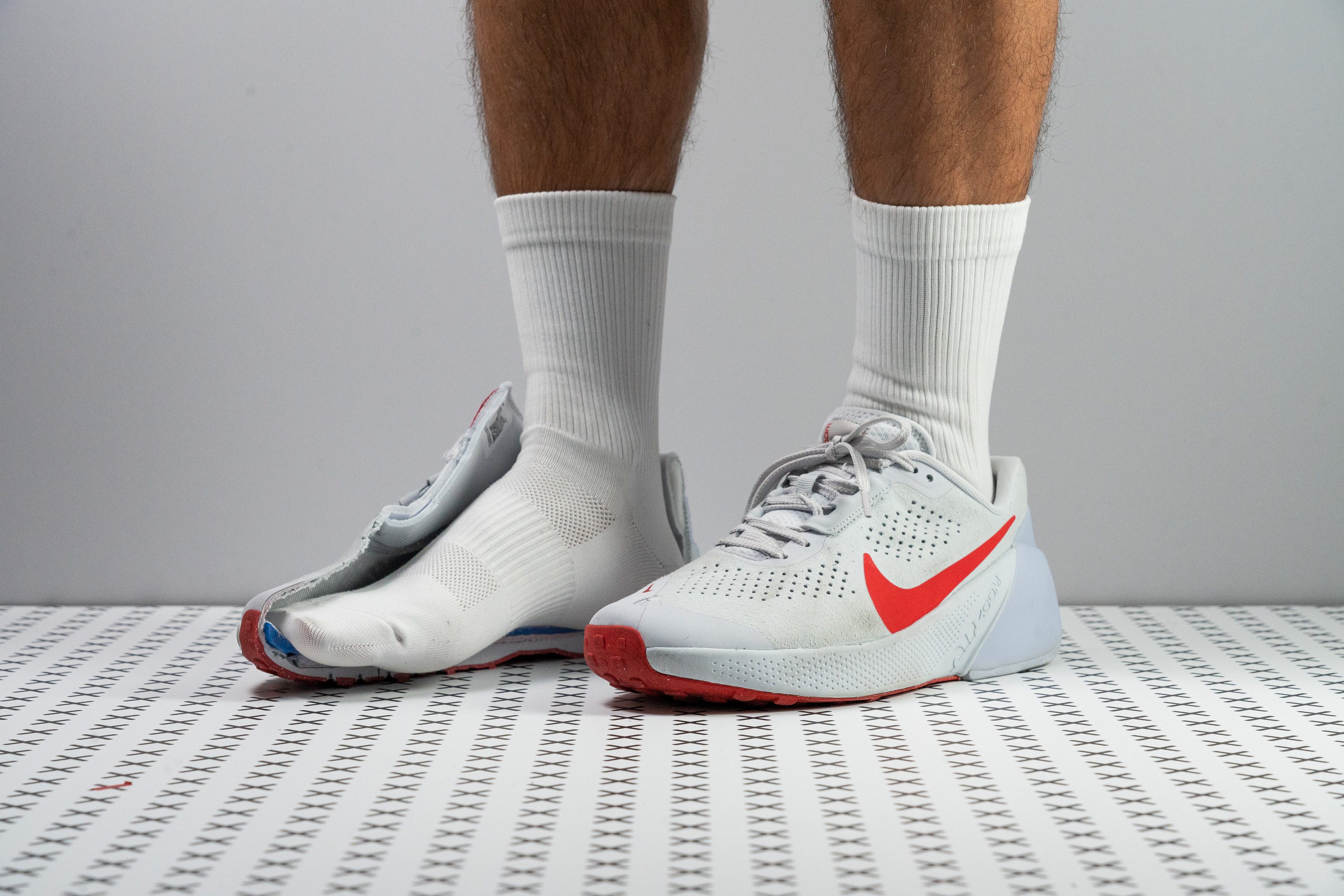











































What makes it the best?
After many workouts and countless hours in the lab, we crowned the Nike Air Zoom TR 1 as the top HIIT Nike training shoe. Its explosive yet flexible nature allows us to perform bursts of various workouts efficiently and effectively while maintaining our steadiness—care of the grippy outsole.
The Air Zoom unit embedded in the midsole serves as the powerhouse force of this shoe, providing unwavering energy for effortless run intervals and jumping exercises. Complementing the bounce is a soft cushion that absorbs impact protection to save us from fatigue. Our durometer confirms it’s 24.6% less dense than the average trainer.
We never encountered issues as we performed mountain climbs and planks as the midsole moved freely with minimal resistance. Our bend test confirms it’s 8.8% more flexible than average, explaining the shoe’s natural feel. To ensure we avoid moving uncontrollably, Air Zoom TR 1 makes its outsole extra grippy. Our durometer reveals it’s 10.0% softer than average, translating to better traction.
Unfortunately, the impermeable upper made our intense workouts feel more heated due to its lack of ventilation. Those looking for breathability will have plenty of other options.
Pros
- Dependable bite on gym floors
- Pretty durable toebox
- Good impact protection
- Nice lateral stability
- Secure heel hold
- Smooth heel-to-toe transitions
- OK for occasional outdoor use
Cons
- Not breathable at all
- Not for heavy lifting
- Not for heavy lifting
Best Nike training shoes for speed
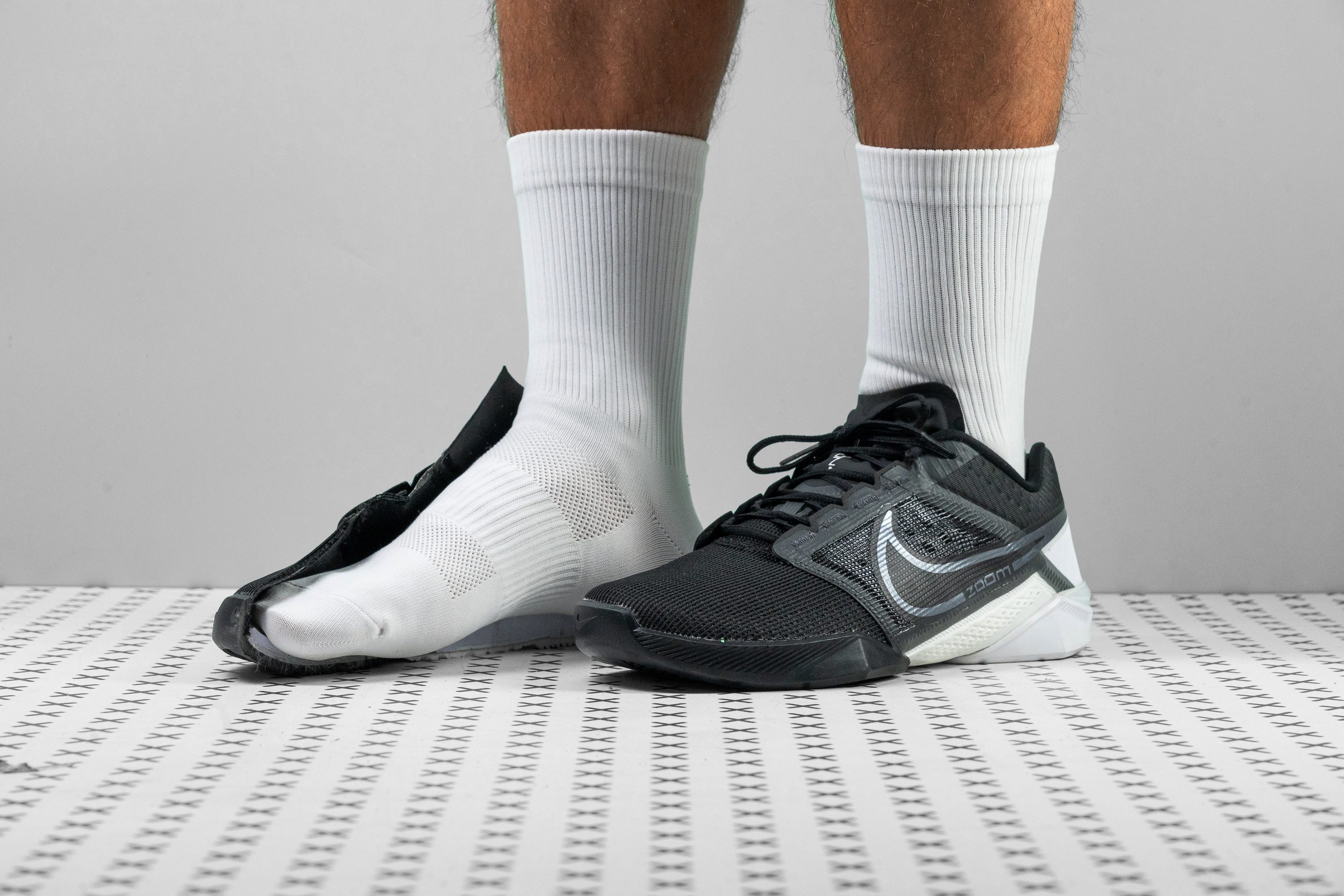




































What makes it the best?
The Zoom Metcon Turbo 2 is our #1 pick for the undisputed speedster in Nike's training shoe stable, as we found that the responsive and bouncy midsole just makes us move faster. It also has outstanding flexibility and a highly durable outsole, which help it seal the deal as our best Nike training shoe for speed.
Whether it's a short run or an explosive jump, the Metcon Turbo 2 always puts a big bounce in our step whenever we have the need for speed. That's thanks to its responsive midsole foam, which has a Zoom Air unit in the forefoot. Using our energy return test, we recorded 63.0% in the heel and 64.7% in the forefoot, both above average.
The shoe features amazing flexibility that makes us feel much more agile while performing plyometrics or other dynamic exercises. It took 18.9% less force than average to bend it 30 degrees in our flexibility lab test.
We also have no doubt that the Metcon Turbo 2’s outsole is durable enough to withstand the pounding of speed-intensive workouts. Not only is the outsole rubber 2.5% harder than the average training shoe, but it is also 17.5% thicker.
However, the Metcon Turbo 2’s heaviness weighs it down as a speedy trainer. At 12.06 oz (342g), it is actually 0.5 oz (16g) heavier than the average training shoe.
Pros
- Bouncy Zoom Air in the forefoot
- Good for short runs
- Perfect for agility drills
- Stable for moderate lifting
- Excellent flexibility
- Amazingly breathable
- Durable outsole
- Reliable outsole traction
Cons
- Upper is not durable rope climbing
- Heavy for a "speed-oriented" trainer
Best minimalist Nike training shoes
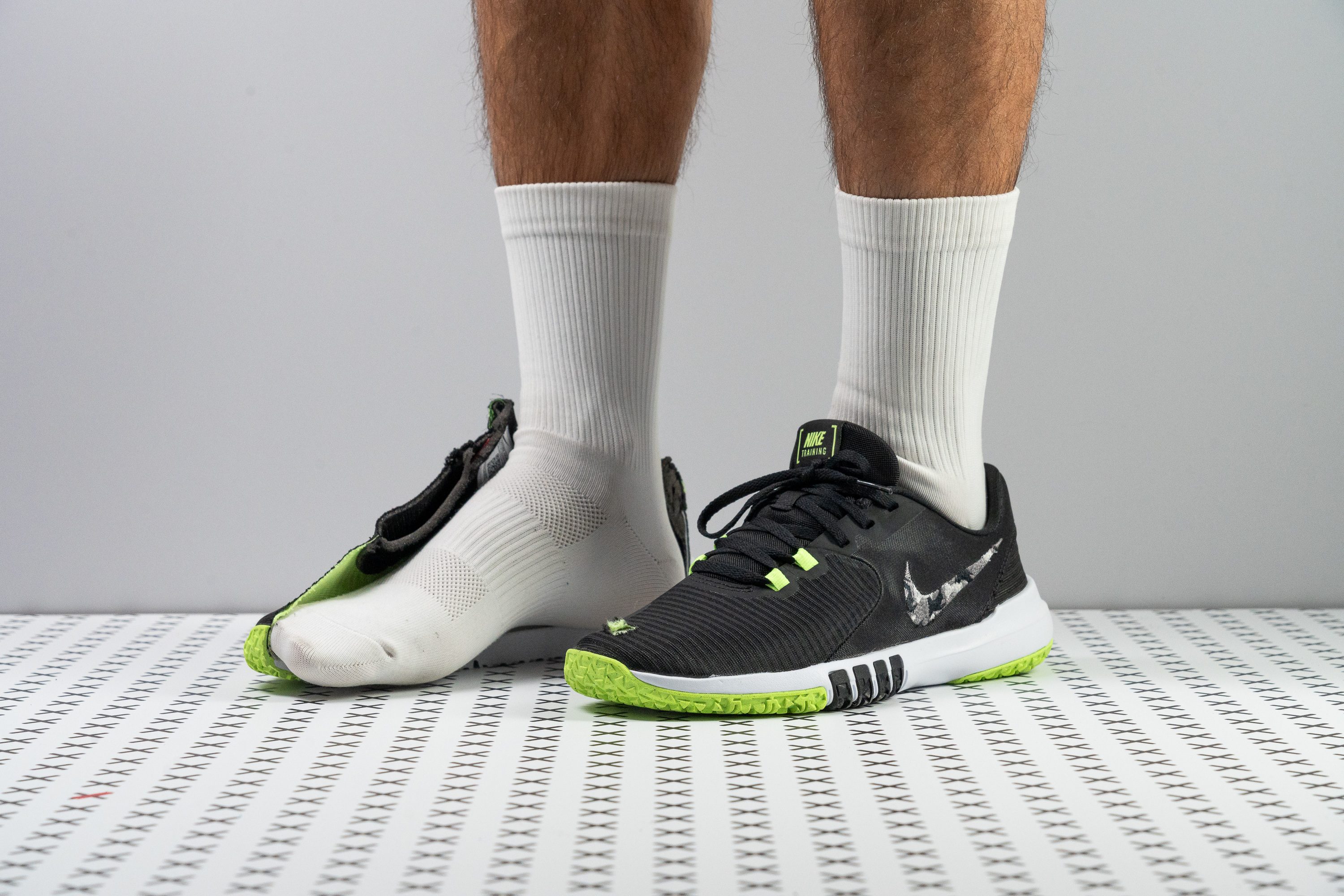





























What makes it the best?
The Flex Control 4 takes the cake as the best minimalist shoe from Nike because its structure had very little resistance to our flexions, allowing us a wider range of motion. Given the amount of air that it let in during our test workouts, we even forgot that we actually have shoes on. Its feather-like lightness is also worth noting.
In the lab, we assessed the heel counter stiffness and torsion resistance with our bare hands. After squeezing it, the heel counter got a score of 2 out of 5 for stiffness. The shoe’s base, for its part, also got a score of 2 out of 5 for rigidity after a number of manual twists. Many points for flexibility (and, therefore, minimalism)!
The upper material is quite light and porous. In the lab, we placed it over a light source and saw that it is covered in numerous tiny holes that definitely let air in and out. Indeed, we felt the air from all directions. This shoe got a 3 out of 5 from us for ventilation.
At 9.8 oz or 277g, the Nike Flex Control 4 is indeed lighter than the average gym shoe, which weighs 11.2 oz or 317 grammes. In the gym, we felt like we had ‘phantom’ shoes on. It’s there to provide protection, but we never felt its weight on our feet.
We cannot recommend this shoe to exercisers who need a lot of impact protection. Our HA durometer in the lab showed that the midsole has a softness score of 32.0, which makes it significantly firmer than the average midsole which has a score of only 27.0.
Pros
- Comfortable in-shoe feel
- Feels nimble and agile
- Lighter than average
- Very flexible
- Foot feels planted
- Budget-friendly
- Good grip
- Simple aesthetics
- True to size
Cons
- Durability issues
- Not for serious workouts
Best budget Nike training shoes
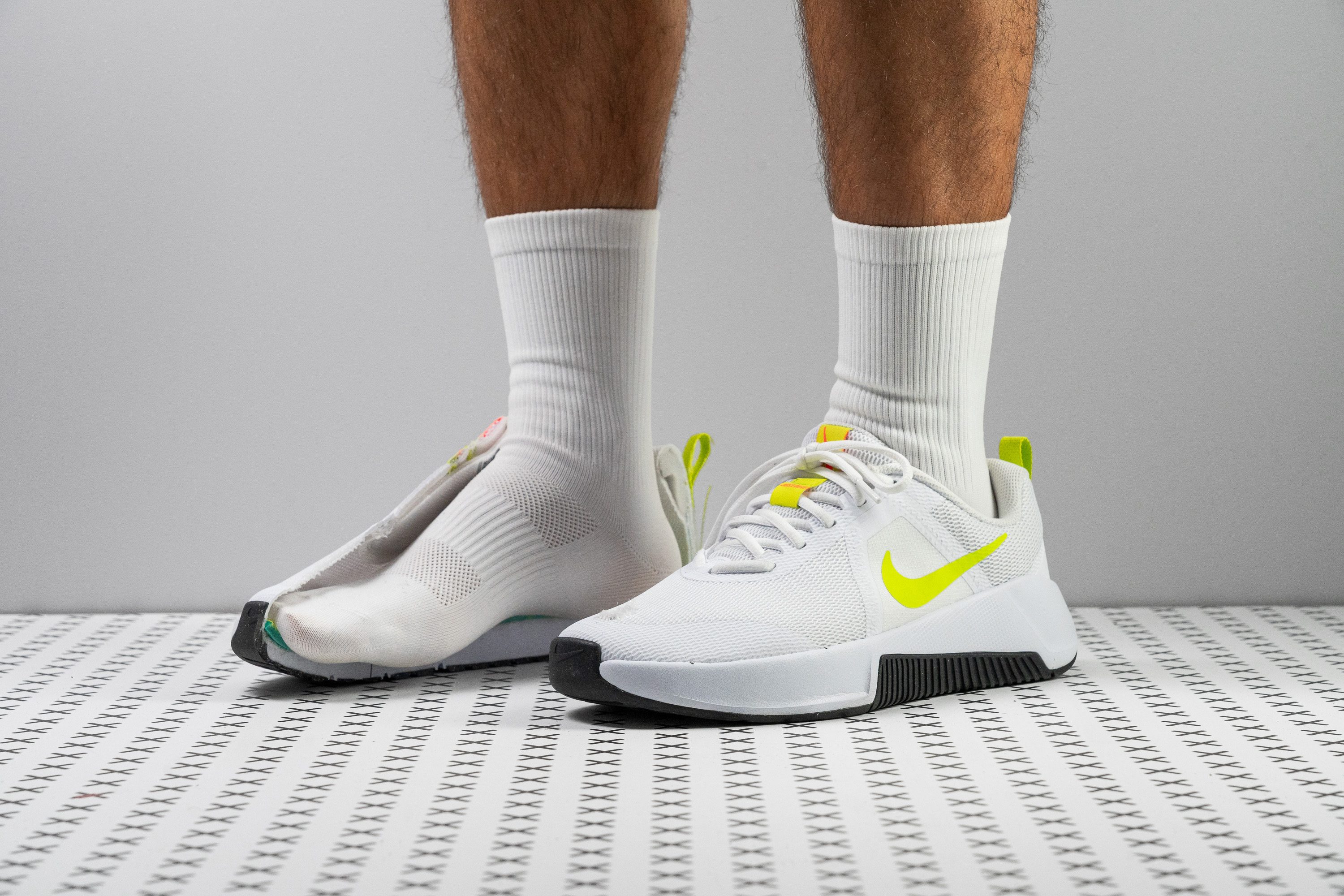

















































What makes it the best?
We got the Nike MC Trainer 3 for only £80, which is at a 25% discount vs. the average Nike trainer! But more than its attractive price tag, it proved to be luxuriously comfortable in our workouts and highly versatile for activities beyond the gym, backed up by our lab numbers. Therefore, it’s our best budget Nike training shoe.
On days we chose to run the treadmill, our feet enjoyed the well-protected landings and plush cushioning. Our calliper reveals an above-average stack height of 30.6/21.8 mm, while our shock absorption test records above-average scores of 97 SA (heel) and 83 SA (forefoot). We felt like we could jump endlessly when performing other cardio drills.
The shoe is very easy to manoeuvre thanks to its light 10.4 oz (296g) build, right below the 10.7 oz (304g) average. In addition, the outsole has deep flex grooves that allow the shoe to bend easily, making it comfortable for walking and other daily activities.
The upper’s immense breathability enhances this trainer’s comfort. However, it didn’t stand a chance against our Dremel-drilling, and it only got a 1/5 for durability. Those who perform abrasive exercises often should find more wear-resistant uppers.
Pros
- Fantastic value for money
- Highly breathable
- Doesn't drag the foot down
- Better cushioned than v2
- Heel bevel is better for running and walking
- Decent stability for moderate workouts
- Good flexibility for lunges and planks
- Accommodating toebox
- Comfortable padded interiors
Cons
- Not for flat and wide feet (narrow midfoot)
- Upper lacks wear resistance
- Weak outsole grip
A buyer's guide on Nike training shoes
Nike training shoes are designed to meet the needs of athletes at every level, regardless of their experience in the gym or fitness level. Still, with so many possibilities, deciding which Nike training shoe is best for you can seem overwhelming.
We are here to help you make the right purchasing decision.
Choosing Nike training shoes for you
Here are five essential factors to consider while choosing a pair of Nike training shoes:
Workout type
Various workout types call for different shoe types. Choose a shoe that is made for the activities you will be performing in your training shoes by taking these activities into consideration.
Consider a shoe with high cushioning and support if, for instance, you plan to do a lot of running. On the other hand, if your workout will mostly involve lifting weights, you’ll want a minimum amount of cushioning and increased traction and ground connection.
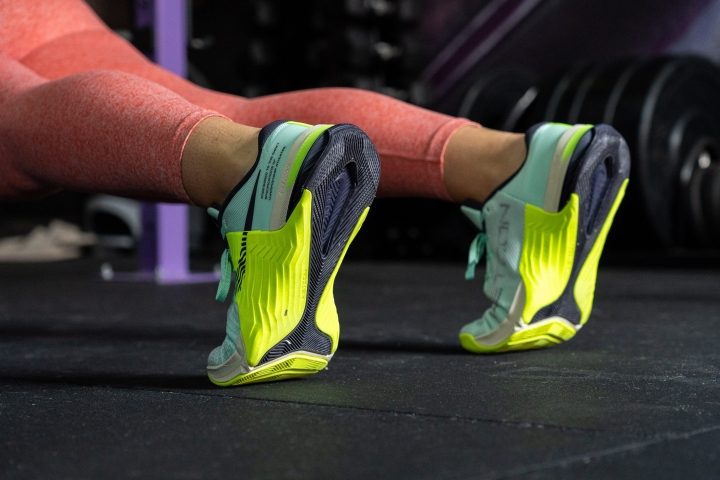
Here is a brief overview of the popular Nike trainers and what they are best for:
| Shoe | Best for |
| Nike Metcon | Crossfit, weightlifting (moderate to heavy), rope climbing |
| Nike Free Metcon | HIIT, weightlifting (light to moderate) |
| Nike Metcon Turbo | HIIT, agility training, short runs, weightlifting (light) |
| Nike Air Zoom SuperRep | HIIT, cardio, aerobics |
| Nike Romaleos | weightlifting (heavy) |
Cushioning
Your personal tastes and the type of exercise you'll be doing will determine how much cushioning you require in your training shoes.
To lessen the impact on your joints and absorb shock, look for shoes with sufficient cushioning.
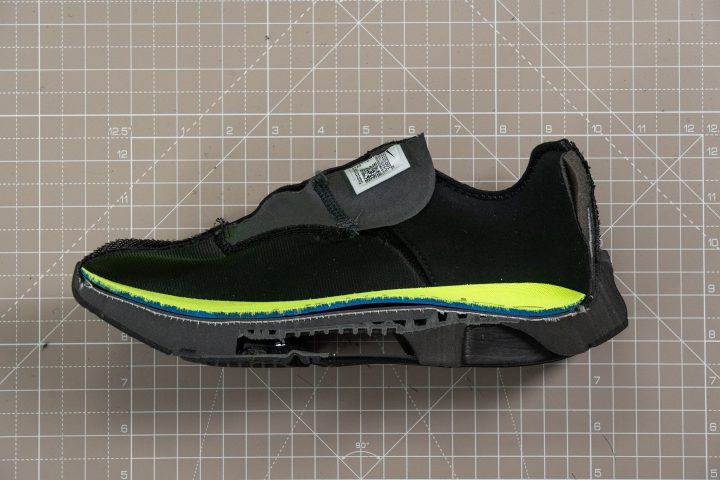
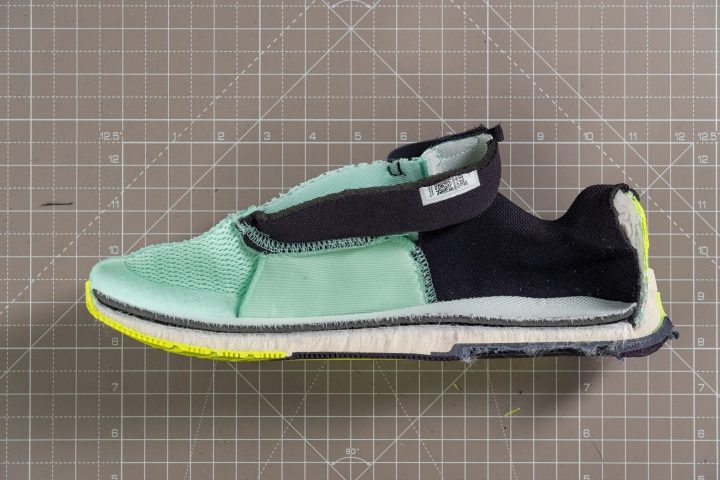
Traction
You’ll need a shoe with a good level of traction to prevent your foot from slipping and sliding during your workout. Nike shoes that incorporate rubber pods or grooves on the outsole are a good option.
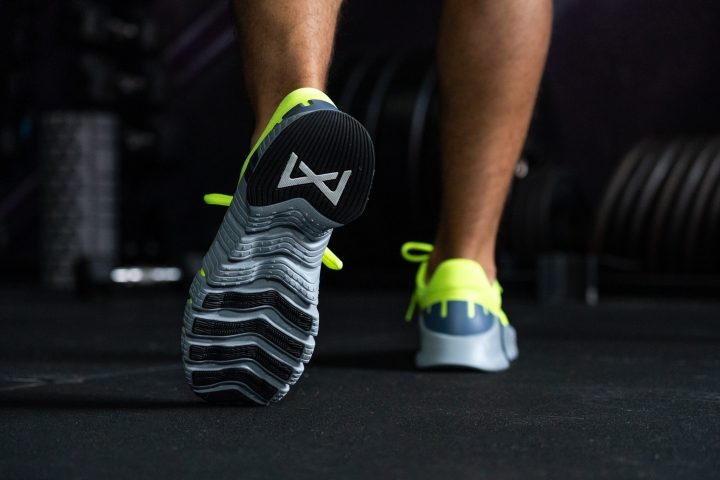
If you frequently do rope climbs, make sure that the shoe has appropriate sidewalls for grip and abrasion resistance.
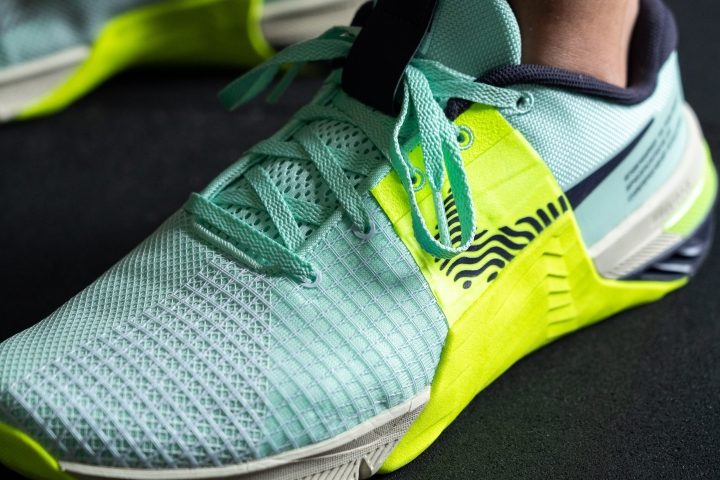
Breathability
Look for a training shoe with a good amount of ventilation in order to keep your feet cool and dry. Mesh or knit uppers are a good option here.
Fit
The comfort and performance of your training shoes depend on how well they fit. In order for your toes to be able to move freely, the shoe should fit snugly but not too tightly. To guarantee a proper fit, try on shoes at the end of the day when your feet are most swollen.

FAQs about Nike training shoes
Do Nike training shoes fit true to size?
The majority of Nike Training shoes run true to size, however, it's important to remember that every person has different feet, so what fits one person comfortably might not fit another person the same way. To achieve a suitable fit, it is always advised to try on shoes before buying.
Due to changes in design, construction, and intended use, various Nike training shoe types may also fit differently. For instance, the fit of a running shoe could differ from that of a cross-training shoe or a weightlifting shoe. When choosing a size for a shoe, it's critical to keep the intended purpose in mind.
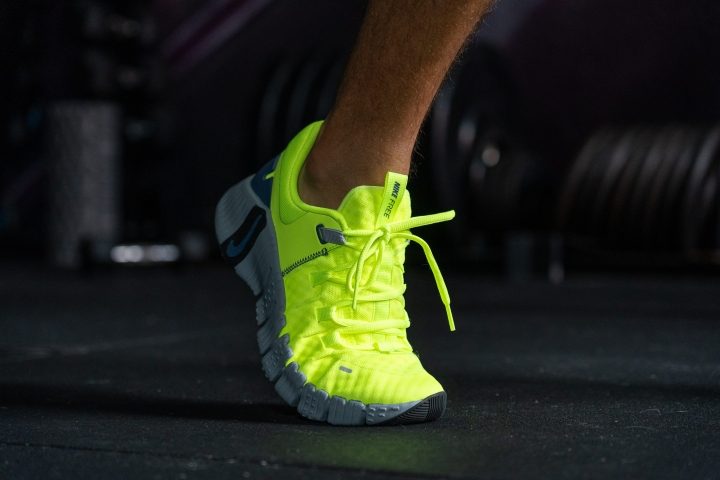
Can Nike training shoes be used for running?
Sure, many Nike training shoes may be used for running, but if running is your main activity, it's best to choose a Nike shoe that is made for running.
What is the difference between Nike running shoes and Nike training shoes?
Nike running shoes are made exclusively for running and offer support and cushioning to lessen the effect of constant forward motion. In contrast, Nike training shoes offer support for lateral motions, jumping, and weightlifting and are made for a variety of sports.
When compared to running shoes, Nike training shoes are frequently more adaptable and may be used for a range of workouts, whereas running shoes are made exclusively for running and may not perform as well in other activities. To ensure the best possible performance and comfort, take into account the kind of workouts you'll be undertaking and select shoes made especially for those activities.

